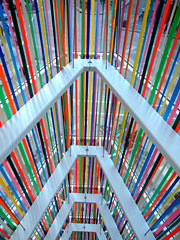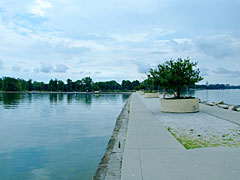Let me just come out and say it: Sometimes the most beautiful aspect of an art museum isn’t its art, but its architecture.
Sometimes you just stumble upon something by accident. Finding the Museum of Contemporary Art during a recent trip to Madison, Wisconsin was one of these happy accidents. I was walking around Madison Square and saw a huge glass building with really long colored stripes behind huge glass windows. Whoever designed this building had style, and I knew I had to go inside and explore.
Free Admission!
Thankfully, I didn’t have to make much of an investment to discover whether or not the Museum was worthwhile because admission is completely free of charge. For the traveller on a budget, it doesn’t get much better than that.
Fantastic View of Madison Square
I entered the museum and climbed its many flights of glass stairs to the fourth floor where there was a charming little restaurant and a door leading outside to the roof. I stepped outside and beheld an amazing view of Madison from the very top of the museum building. The museum features art on each of its four levels, and some sculptures had been placed up here. Though they’d been exposed to the elements for years, it was alright because these sculptures were clearly built to withstand the weather.
The only sculpture that caught my eye on the roof was a plant-like white sculpture. It’s flowing form fit well with the cumulous clouds behind it. But the best part about being on the roof was the view itself. Looking down to the street level, I could see the Orpheum Theater, and in the distance I could even see the Golden Lady sitting atop the Madison Capitol building. If the museum itself is closed when you visit, you should still be able to walk up to the roof for some really excellent photo opportunities.
The Sunlight Dances with the Glass Staircase
Perhaps the Golden Lady gave me her blessing that day, because as I was walking back down the glass staircase, the sun was setting just behind the steps. I was there just in time to capture the beautiful way the light interacted with those translucent glass steps. It’s difficult to describe in words, but it was a truly memorable experience.
I walked down to the ground floor and noticed that each colored ribbon was actually a single piece of vinyl that ran the entire length of the museum — suspended from the ceiling of the 3-level stairwell all the way down to the bottom of the ground floor where I was standing. These seamless ribbons created an interesting effect as the setting sunlight shone through them, striping the floor in shadow. I could easily see things happening at street level because the only thing separating me from the street was a piece of glass. In fact, it was pretty impressive how much glass was used in the construction of this building, and the result was a truly unique structure.
Silly Scared Artists
Unfortunately, I was not allowed to photograph any of the strange paintings on level 3 of the museum. And although you might not agree with me at first, these restrictions have their root in fear. In this world of truly ubiquitous digital photography, I have to wonder how long it will be before people realize one of the facts of this new century: if it can be seen with the human eye, someone will manage to photograph it. Being an artist myself, I’ve learned to cope with that fact. Plus, putting artificial barriers on photography only limits the exposure an artist can achieve. After all, a photograph is never an ample substitute for actually being there.
Lost in the Overture Center
I wanted to explore more, but they sort of kicked me out since it was closing time. However, I did return the next day, and as I was wandering around the first floor of the museum I actually got a bit lost. I found myself in a strangely futuristic white hall with white columns and tile. I found out that this was the Overture Center, and it was connected to the museum.
More fascinating architectural creations were to be found in this area, further reinforcing that the greatest work of art was the very thing I had been standing in and walking around in all day — the building itself. The carefully curving halls and meticulously arranged columns lent the building an atmosphere that very few buildings ever achieve — a kind of minimalistic elegance.
Recommended Experience
To be brutally honest, unless you’re a big fan of avant garde style painting, the view from the roof and the building itself may be more interesting to you than the exhibits.
For this writer, the view alone is worth the time to check out the Madison Museum of Contemporary Art, and I plan on visiting again the next time I’m in Madison. Check out their website at MMOCA.org, and be sure to look in the gallery for high resolution photos from this trip.
Check out all of the photos from this location in the Madison Museum of Contemporary Art album. All photos in the Gallery can be used as widescreen desktop wallpapers because they are high resolution (1920×1440).







